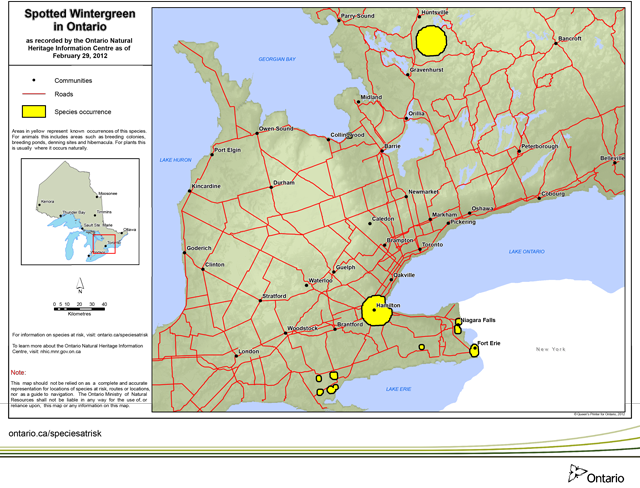Spotted wintergreen
Scientific name: Chimaphila maculata

Cover photo credit: Allen Woodliffe
Status
Threatened
“Threatened” means the species lives in the wild in Ontario, is not endangered, but is likely to become endangered if steps are not taken to address factors threatening it.
Date added to the Species at Risk in Ontario List
The Spotted wintergreen was already assessed as endangered when the Endangered Species Act took effect in 2008. The species was reassessed as threatened in November 2017.
Read the assessment report PDF.
What it looks like
Spotted Wintergreen is a low-growing, evergreen herb that reaches about ten to 25 centimetres in height. It has a whorl of smooth, dark green toothed leaves that have prominent white stripes along the midvein on their upper surfaces.
An umbel (a flat-topped or rounded flower cluster in which the individual flower stalks arise from a common point) of one to five nodding flowers occurs on a single stalk arising from the leaf whorl.
Petals are five in number, reflexed and white or pink. The fruit is a roundish capsule.
Where it lives
In Ontario, Spotted Wintergreen occurs in dry oak-pine woodland habitats with sandy soils
Typically, dominant tree species include White Pine, Red Oak, Black Oak, and American Beech. The species does best in semi-open habitats.
Where it’s been found in Ontario
Spotted Wintergreen ranges from New England and Michigan south to Georgia. It also occurs in Mexico and Central America.
In Canada, it is only found in a few locations in southern Ontario in Norfolk County and the Niagara Region. It is believed to have been been extirpated from Simcoe Kent, Middlesex and York Counties, Hamilton-Wentworth Region and the District of Muskoka.
There is a record for Spotted Wintergreen in Quebec but it is believed to have been introduced and now no longer persists.

View a larger version of this map (PDF)
What threatens it
The primary threat to Spotted Wintergreen is habitat loss and degradation from recreational uses and forestry operations.
Lack of suitable habitat is a key threat since dry, sandy mixed woodlands are very uncommon in southern Ontario.
Pedestrian and ATV traffic also pose a threat and may be responsible for the loss of at least one occurrence.
Action we are taking
Threatened species and their general habitat are automatically protected
Recovery strategy
A recovery strategy advises the ministry on ways to ensure healthy numbers of the species return to Ontario.
Read the executive summary (February 18, 2010)
Read the recovery strategy (February 18, 2010)
Government response statement
A government response statement outlines the actions the government intends to take or support to help recover the species.
Read the government response statement (November 18, 2010)
Five-Year Review of Progress
A five-year review reports on progress made toward protecting and recovering a species, within five years of publishing a species’ government response statement.
Read the report on progress towards the protection and recovery of 13 species at risk, including Spotted Wintergreen (2015)
Habitat protection
General Habitat Protection - June 30, 2008
What you can do
Report a sighting
- Report a sighting of an endangered animal or plant to the Natural Heritage Information Centre. Photographs with specific locations or mapping coordinates are always helpful.
Volunteer
- Volunteer with your local nature club or provincial park to participate in surveys or stewardship work focused on species at risk.
Be a good steward
- Private land owners have a very important role to play in species recovery. If you find Spotted wintergreen on your land, you may be eligible for stewardship programs that support the protection and recovery of species at risk and their habitats.
- Pollinators, such as bees, are in steep decline across the globe and they play a key role in the survival of many of Ontario’s rare plants. For information on how you can help scientists monitor pollinator populations in Ontario visit:
www.seeds.ca/proj/poll. - The Carolinian forests of southern Ontario support an amazing diversity of plants and wildlife, including many species at risk. Carolinian Canada is working to help recover species at risk and their habitats. For more information, visit:
www.carolinian.org/SpeciesHabitats.htm.
Report illegal activity
- Report any illegal activity related to plants and wildlife to
1-877-TIP-SMNR (847-7667) .
Quick facts
- Typically, Spotted Wintergreen is found close to waterbodies. In fact, all sites in Ontario are found close to water.
- Spotted Wintergreen flowers in mid-July for about three weeks. It is believed that Spotted Wintergreen is pollinated primarily by bumblebees.
- The seeds of Spotted Wintergreen are believed to be dispersed by wind.
- Aboriginal peoples used Spotted Wintergreen for a variety of medicinal purposes including as a poultice, for rheumatism, and for the treatment of colds and fevers.